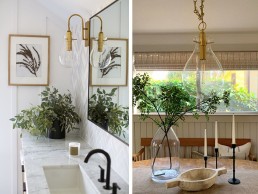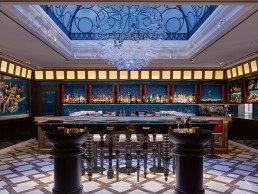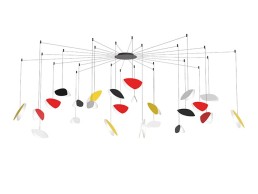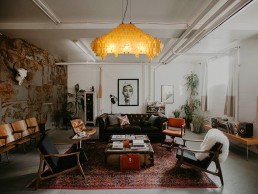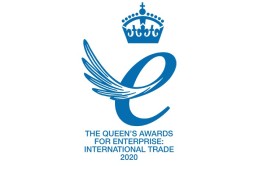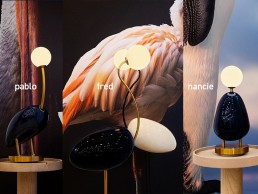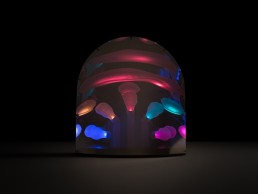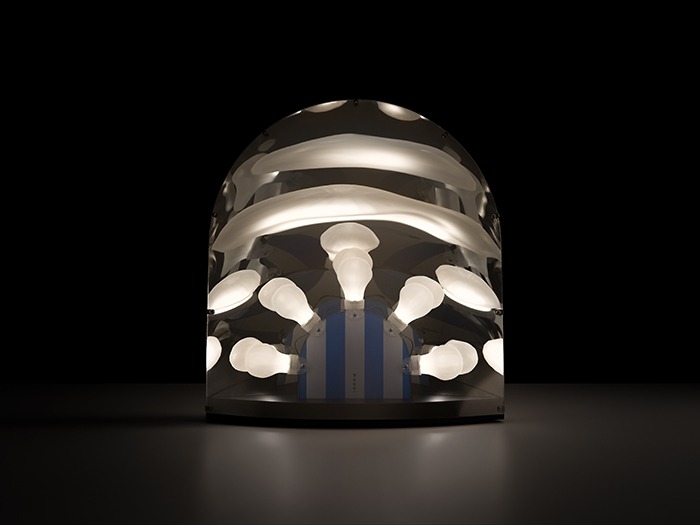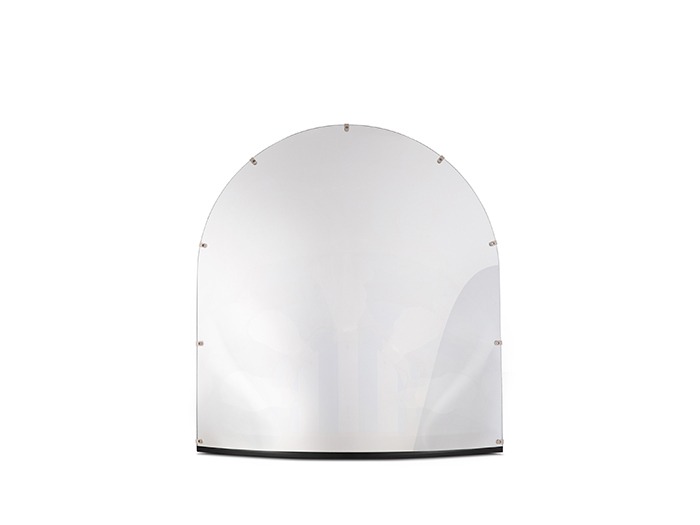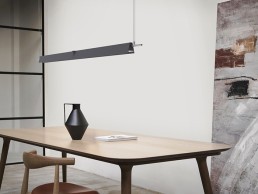Becki Owens collaborates with Hudson Valley Lighting
(USA) - Interior designer Becki Owens works on new range for Hudson Valley Lighting.
Combining sophisticated modern design and Californian bohemian influences, the lights are inspired by the Californian beach town of San Clemente where Owens is fortunate enough to call home.
The unconventionality of bohemianism and Owens’ love of contemporary clean lines blended with coastal, mid-century shapes, sees the collection exude style that has been carefully refined to the highest standards of quality.
Each piece is adaptable and timeless, giving a new lease of life to everyday spaces and providing a focal point to the room that lures you in. Key pieces from the collection include the Ivy pendant and Ivy sconce.
The pendant is available in three sizes and two finishes: aged brass and polished nickel and features a large clear piece of glass in a simple yet powerful teardrop shape. Three pins hold together the expertly-crafted curve of the shade, which is complemented with a choice of a stylish chain or classy gooseneck arm to fix Ivy in place and give the pendant that smart and sleek finish.
The sconce is a little bit different to the rest of the range. Despite it usually being found around the edges of a room rather than in the apparent centre, it demands to be seen and radiates subtle elegance and charm. A perfectly curved arm cradles an immense teardrop shaped glass, which is mounted sturdily by three pins. Available in one size, and two finishes: aged brass and polished nickel.
hudsonvalleylighting.hvlgroup.com | beckiowens.com
Peter Bowles
British lighting manufacturer Original BTC was founded in 1990 with design, quality and attention to detail at the forefront of its philosophy. Celebrating its 30th anniversary this year, founding designer Peter Bowles sat down with darc’s Editor Helen Ankers to reflect on the company’s design story so far.
With two additional brands – Davey Lighting and Beadlight – now also under the Original BTC umbrella, the decorative lighting group as we know it today is fortunate enough to own six production facilities dedicated to its designs; these include a ceramics factory, glass factory and metal works. The company’s headquarters and assembly factories are based in Oxfordshire, where Original BTC was founded, and it has showrooms in London, Paris and New York.
A family-owned company with six family members directly involved in the business, childhood visits to his father’s manufacturing facilities opened Bowles’ eyes to the clean lines of traditional factory fittings and the versatility of mid-century style. Having moved to France – initially with the view of improving his language skills – Bowles found himself working the machines at a cutlery manufacturer, igniting his passion for the “crash, bang, wallop of production" and giving him a deeper understanding of how things are made and how you can develop products generally.
On his return to the UK, Bowles initially stuck with the cutlery industry – working with the likes of Habitat, supplying and designing products. However, challenged by the design limitations of cutlery, in 1990 Bowles went back to his roots opening the Oxford-based lighting factory Original BTC. “There’s only so many prongs you can put on a fork and what shape a spoon can be,” he tells darc.
“You’re quite constrained by what you can do, so I thought why not design other products. I have always loved designing and so I got a pencil and paper out and did some sketching… I approached Habitat to see if they would consider me as a lighting partner and they said yes. So, I made some samples and before I knew it had an order of 250 for each of the two lights I had created prototypes of. After that, the designs just kept coming and within 18 months I was Habitat’s largest lighting supplier with 35 lights.
“My goal was to design and produce lights that you are instantly at home with, that will fit comfortably for many years to come. Lighting is such a wonderful product area to be working in as a designer because you can use so many different materials, shapes and sizes… it’s never-ending really! You have so much freedom in designing lights – I felt liberated when I made the move.”
Describing his design style as ‘relaxed’, for Bowles mass production and endless amounts of plastic isn’t for him. “There are different pleasures when you’re buying a product,” he says. “You could be buying something because it was cheap – the pleasure comes from the fact it was so cheap – but it’s a short-term pleasure. Whereas when you buy something that you really like, it’s very much a long-term investment – you love it for what it is, the price is irrelevant. I like to think this is why people buy Original BTC lights.
“We’re not ‘mass market’, a lot of work, effort and attention to detail goes into them and the lights are there to be cherished. We get people writing to us after owning a light for 10+ years expressing their upset that the shade has broken and is there anything we can do to help – there’s a real affinity with the lights.”
With longevity at the forefront of Bowles’ mind, ensuring the products are produced in a sustainable manner is of course key and something that he feels the wider community is taking more of an interest in. “I think people are starting to care more,” he says. “There’s a lot more attention, focus and thought about what’s going into a product. Longevity is really what all product designers should be aiming for – so to be able to design something like the Hector range that’s become an iconic design 30 years on is fantastic. People love it just as much – if not more – than when we first designed it.”
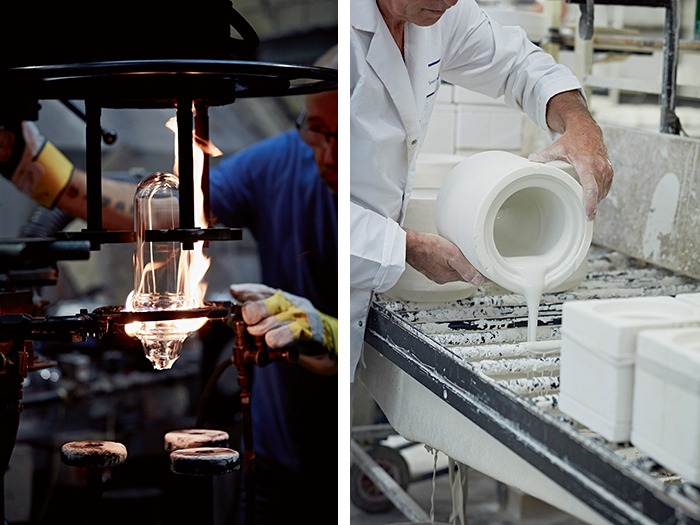
As one of the first product designers to capture the appeal of industrial styling and the first to use bone china shades for lighting, Bowles explains how the idea to use the fragile and ornate material originally came from the humble teacup.
“If you have a creative design mind, you look at the world and objects in different ways… you have an open mind and a different view on how things could be or should be. I was literally looking at a teacup one day and noticed its translucency – you can see your fingers through it when the sun shines on it. The bone china factory in Stoke-on-Trent that I approached about producing lights initially thought I was nuts!”
Bone china is a very difficult material to work with, whether you’re making lightshades or teapots, with contamination a big issue for manufacturers. “We take the material as far as we can, but bone china is incredibly fragile until you fire it. So, you have to design in such a way that the structure will support it as best it can – there are all sorts of tactical issues to deal with, it’s not an easy material at all but it is very rewarding once it all comes together.
“We have people come to our stands at trade shows asking how on earth we’ve produced these products – even people in the ceramics industry think it’s an incredible achievement. The Fin range in particular is an incredible work of art due to the material, as is the Hatton range, which uses diamond shapes. They are both incredibly complicated and something that people haven’t really done before.”
When asked ‘what a lighting product should bring to a space’, for Bowles it’s all about pleasure. “Regardless of whether the light is switched on or off, the piece should be a pleasurable thing to have in your house. Whether it’s something more architectural in style, straight-lined, a pendant or large statement piece, it should be interesting and part of the atmosphere and style that you’re trying to create in your home. It’s about the functionality of the light of course but it’s also about the atmosphere and ambience you’re trying to create.
“The wonderful thing about bone china, which I’ve always loved, is that you get this very warm, soft light but it’s still functional and bright. The light produced is complementary and flattering to your complexion – it’s almost like a soft focus on a camera. But it’s not just about the bone china, the metals we use and the different types of finishes can be just as attractive when they’re turned off.”
As a family-run business Bowles and his son Charlie are at the helm of the in-house design team – leading the brand’s vision and style, ensuring every product looks as though it has come from the same stable and looks ‘like an Original BTC’. And while technology is undoubtedly driving the decorative lighting industry forward, with some companies pursuing a much more modern look and feel to their products, Bowles has never been one to use technology ‘for the sake of it’.
“Our products haven’t dated and you can use the latest LED lamp sources with them instead of the incandescent lamps. This has remained our approach to design as it’s far better to have a product that can adapt to new technology, rather than being fixed and becoming out-of-date five years later.
“We are however a very tightly run company and can adapt and change to use new technologies as they become available if we feel we should. It’s important for us to stay up-to-date but that doesn’t mean you have to ‘chuck the baby out with the water’. I’m now 63-years-old and younger people in our company are better placed to know which technologies we should use as a business. Original BTC’s future is in very safe hands and the fact my children are now involved is fantastic. Everyone involved is in it for the long-term, with extended family helping when needed; the suppliers, our clients and our amazing team – some of which go right back through the years.”
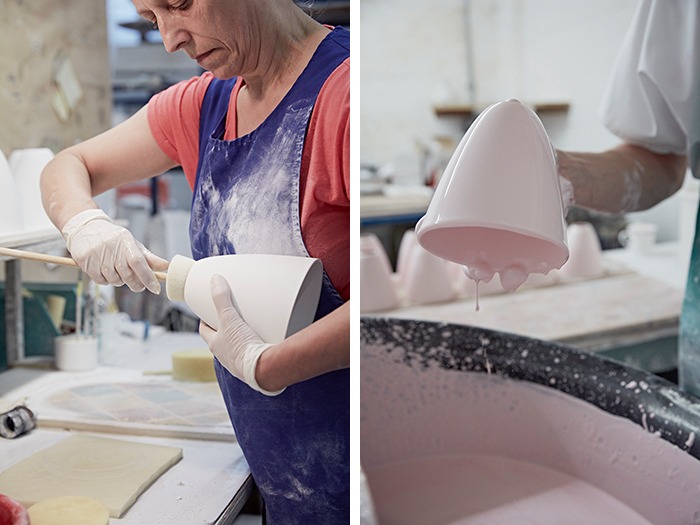
As part of Original BTC’s 30th anniversary celebrations, the Hector light, which was the brand’s first product to be produced in bone china, has been updated with a satin brass stem and black cotton braided cable, replacing its original satin chrome, sand and taupe finishes. Hector 30 shades and bases are slip-cast moulded by hand, then smoothed with sponges before firing, with each component passing through the hands of 10 craftspeople, over a period of six days.
Bowles looks back on the Hector’s origins: “It started life as a table light then quickly progressed into wall, floor and so on. I was mainly thinking about what I could create with bone china. I like things to be solid, good to touch… it sounds bizzare but if you touch any of our products, they feel nice. There is a lot of detail that you can’t always see but I know it’s there and I like the detail in the completed product.
“At the time, I felt you couldn’t see how the product actually worked and so I decided I would strip it all back and actually have the electrical cable visual, as well as the lamp holder. Hector is quite a collective mix of materials and raw functionality, it’s not trying to be slick at all and that is the beauty of it – it’s such a relaxed product.”
The braiding on the cable is all thanks to the humble iron as Bowles explains further: “I was getting ready for a meeting where I was going to show the Hector design to my biggest client and I noticed the black plastic cable and hated it... then I noticed my iron, with the braided cable – so I cut it off and attached it to the sample light. Lucikly my client loved it and from there I bought a braiding machine and the rest is history.
“You’ll see braided cables all over the place at trade shows now but nobody does it like we do, there’s no synthetic polyester being used.
“I always resisted bringing out a different version of the Hector because I think sometimes, when you do, you lose the focus and status of the product. So, what we’ve done for this anniversary piece, is update all the metal parts for a beautiful satin brass finish; it’s made the product a bit more sophisticated. It’s British, timeless and a classic piece.”
Moving forward, for Bowles Original BTC is very much still in ‘expansionary mode’ and there are no plans to sit back and relax, despite the current Covid-19 induced climate. “We want to move forward and develop new products,” he says. “Lighting people’s houses – it’s such a pleasure to see your product being used, whether this is in a residential or commercial project and we want to be able to continue doing so. During these uncertain times, we have been checking with our suppliers and are sure we will all come through this terrible situation together, we don’t want to lose more UK manufacturing. We want to make British products using British components… this is the way forward for us.”
Great Scotland Yard Hotel, UK
HBA and Illuminate Lighting Design collaborate to reinvent London's Great Scotland Yard into a hotel that moves away from conventional design.
The new Great Scotland Yard hotel in Westminster, London, is part of the Hyatt brand’s Unbound Collection. The former headquarters of Britain’s Metropolitan Police has been converted into a 153-room hotel and away from the conventional hospitality codes, it expresses individuality - a burst of colour within the monochromatic and conventional Whitehall. While catering to meet the needs of a luxury hotel, the destination is one with various experiences, as opposed to a collection of spaces.
Exquisitely sculpted interiors and sophisticated details set the background for the eclectic decorative elements that pay tribute to the past times of Great Scotland Yard. It creates a destination, which reinvents a London landmark - inviting international visitors to journey through various aspects of local culture. The building is an icon, hiding more than a century of dark and infamous secrets.
Interior design studio HBA was challenged to keep the soul of the building and pay homage to the heritage rather than just bringing new life to old walls. Guests are invited to experience the rich history through new eyes as they enter a place where the past and present merge to tell a new chapter of this building’s history. An unexpected play of Edwardian inspired colours and patterns relive the timeless elegance and sophistication of the era with a flair of contemporary details.
At the hotel entrance, a decorative Preciosa Lighting piece titled 'Exploding Clock' signifies that the guest is entering a place full of history. As they enter, they step down to a lounge that leads to various social venues - a parlour, bar, restaurant and club room coexist, along with two reception desks created from antique luggage.
For HBA Partner David T’Kint, the biggest challenge on this project was designing a suitable space in a landmark building, in the highly competitive market of London. The team had to develop something that really made a statement and was different to anything already out there. “We came up with a strong narrative from the start,” he tells darc. “’Unlock the secret’ - in reference to what occurred behind the closed doors of the Great Scotland Yard, which was then interpreted into the interiors that tell a story in-line with its long legacy.
“The property is designed as a collection of food and beverage outlets orchestrated by celebrity chef Robin Gill, as opposed to a regular hotel,” continues T’Kint. “It has co-working areas downstairs and 153 guest rooms upstairs. The atmosphere of each outlet is unique, however each one has to connect to the others – lighting plays a key role in achieving this.”
HBA worked closely with sister brand Illuminate Lighting Design on the project; Rikus DeKock from the lighting arm explains the lighting design in a bit more detail: “The decorative lighting forms part of the overall interior design as it is in such close proximity, so it all had to flow together. With this in mind, the same inspiration for the interior design flowed through to the decorative lighting selections as well. We worked closely with the interior design team to ensure the aesthetics were in-line with the technical requirements and that we could control these with the architectural lighting.”
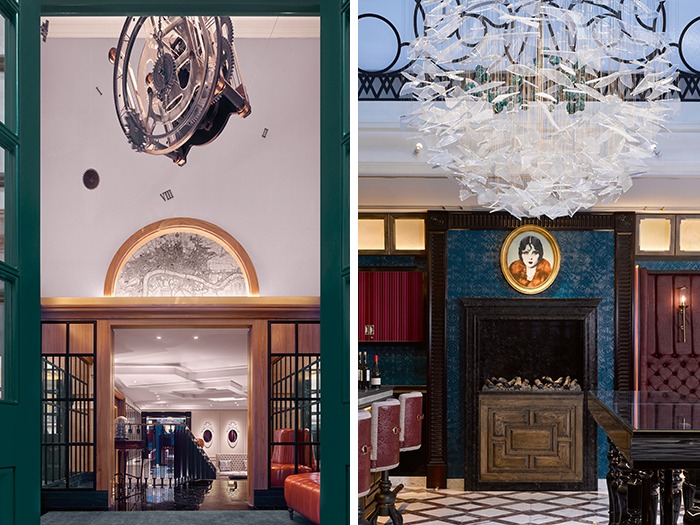
Hotel bar Forty Elephants is an unexpected play of Edwardian inspired colours and patterns and the space is a nod to the 19th and 20th Century all-female London crime syndicate who specialised in shoplifting – the gang was known for its longevity and skill in avoiding police detection. A notable element of the bar is the stunning feature chandelier created by Czech lighting brand Lasvit, which has been created through a series of broken glass, signifying the way the female gangsters would break into stores in the London area. Buried in the centre of the installation is a jewel-toned necklace representing the members of the Forty Elephants gang. The spirit of the thieves is also signified through glass engraved portraits hung high on the walls.
Within Sibin Whiskey Club, which is hidden behind a secret door disguised in a bookshelf, the alcoholic beverage is celebrated through a warm, reckless and unexpected space. Taking a contemporary twist on classic interiors, Sibin is sculpted into three spaces with the bar at the heart of it all. The spaces are divided by whiskey-filled display cabinets on wheels rolling above the copper-leafed, distressed wooden floors. In terms of lighting, HBA and Illuminate again worked with Lasvit to create a ‘bottled ceiling’ feature.
The Yard is a local restaurant destination that feels like an escape to the countryside; a sophisticated yet informal restaurant. The space boasts a barrelled ceiling, vintage lamps and various off-the-shelf lighting pieces from UK-based Chelsom – these set the scene of a comfortable environment making guests feel at home.
Elsewhere in the hotel, The Parlour bar creates an atmosphere of the West Indies through tropical landscapes, which is emphasised with a wicker barfront. Juxtaposed with a black and white chequered floor and an oversized fireplace, a warm setting with a colonial twist is created for afternoon tea or cocktails.
The apartment downstairs – Grace and Favour – reinvents the typical working space, providing a way to do business within the comforts of home, providing various sized meeting rooms, games, a kitchen, a lounge corner to relax and a fitness room to re-energise.The wall panelling has a playful twist adding a contemporary moulding full of surprise, complemented by the herringbone pattern floor that conveys the apartment atmosphere. Each area is properly curated for the guest’s needs and is complemented by Ingo Maurer’s Tu-Be light fixture.
As you would expect, each of these individual areas have their own lighting requirements. “All bars have been designed to be quite moody even during the day,” says T’Kint. “While the restaurant atmosphere varies at different times of the day, the co-working space is brighter because of its function. For the guest rooms we have given each space multiple pre-sets that the guest can choose from.
“Without lighting there is nothing – lighting, both natural and artificial brings depth to a space. Beyond functionality, lighting also creates the atmosphere – nobody wants to have a late-night drink in an over-lit bright space, or write a letter on a table in the dark!”
Upstairs in the guest rooms, preserving the Edwardian and Victorian architecture of the 1820s Grade II listed building was taken into consideration. Typical for London, the guest rooms have a small footprint of 19-21sqm, however they include all amenities you would expect from a five-star hotel.
Paying homage to the police history is seen through the carpet design integrating concepts of badges and uniforms creating a modern pattern, along with a custom-designed wall-covering with hidden messages of a past era. A warm colour scheme helps bring in as much light as possible, while decorative lighting fixtures from Chelsom add to the interior design.
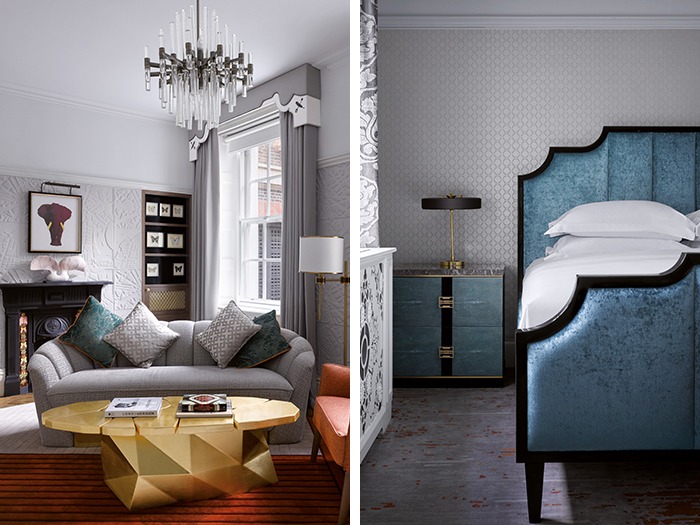
Great Scotland Yard also houses 22 suites as upgraded extensions to the guest room experience. These suites include a marble-cladded fireplace, a relic kept from the existing architecture and in rooms where space allows, the suites are complete with four-poster beds. Guests walk into the luxurious bathrooms to find fully clad walls of book-matched stone running through the shower and washroom. As well as the suites, the hotel also features a standalone townhouse and presidential suite.
While physically connected to the hotel, Number 1 has its own street entrance and is an eclectic and unique expression of the Edwardian and Victorian style that is seen through the architecture. There is a residential feel to the suite as it is equipped with a kitchen, dining room, and study while fully catering to the accommodations of a 5-star suite. The fully customised carpet and one-of-a-kind furniture pay attention to detail and add to the unique experience, with the final touches of the artwork setting this suite apart.
In terms of challenges on this project, for DeKock the main element the team had to work around was the space itself. “Working on an existing building we were limited by the layouts and workable ceiling heights,” he says. “We had to rely a lot on the decorative lighting fixtures to add functional light to areas and had to use a lot of integrated lighting to balance the overall lighting scheme.
“There were a lot of structural limitations. Some areas had very minimal to no desired lighting effect and in most areas the decorative and architectural lighting is in such close proximity it made it very difficult to balance the overall lighting design. We used some unconventional lighting details and some special lighting fixtures to achieve this balance.
“My final impressions of the overall design are good. I believe in the end we captured our original design intent. The decorative lighting enhances the interior design to bring focal points to each space but still captures the overall flow and quirkiness of this project. The architectural lighting adds the correct lighting levels where needed and highlights certain design elements; as the decorative lighting is the main source of light, the final design is a balanced mix of functional and purely decorative lighting.”
www.hba.com
www.illuminateld.com
Radius Payment Solutions Case Study
Part of the 2019 [d]arc room: live series in collaboration with Light Collective, we look back at Helen Ankers’ Q&A with designer John Williams of Space Invader; looking at how light was used to add the finishing touches to the studio's Radius Payment Solutions project.
BIID introduces enhanced online resources
(UK) - Web-based initiatives introduced to support interior designers during global pandemic.
With many interior designers now adapting their businesses and working remotely due to the COVID-19 lockdown regulations, the BIID has extended its online offering with new content to provide additional support and guidance to those working in the interior design industry.
“We understand the challenges and concerns that many interior designers are facing right now in these unprecedented circumstances. So, it’s vitally important, now more than ever, for our community to come together and help each other,” says BIID President Harriet Forde. “The BIID is committed to supporting its members and we have introduced a range of new, online initiatives that will enable our members to stay connected, benefit from peer-to-peer support and continue their learning and development.”
A new webinar series will discuss some of the challenges interior designers and design businesses may face during this turbulent time. The webinars will explore a range of topics including legal issues, online collaboration tools, financial support and other advice on navigating a design business through this uncertain period. The digital sessions will be hosted by BIID Council members and provide an opportunity for members to engage and ask questions in an interactive way with a dedicated Q&A.
The BIID has a comprehensive list of CPDs available to its members, but with many now postponed, the institute has looked at ways to offer this training remotely. The BIID is working closely with its CPD providers and supporting them to bring their CPDs online and a selection of these are now ready, allowing interior designers to connect with suppliers and continue to build their knowledge from the comfort and safety of their home.
A series of new Designer Digital Meetups have also been introduced. These informal sessions are designed to encourage members to connect with each other online and share their own experiences of trying to run design projects, work from home and plan long-term during these uncertain times.
Not only will this allow interior designers to support one another with business advice, but it provides a place for members to connect while working from home. These ‘virtual chats’ are designed for up to five members at a time. These initial meet-ups are open to BIID Registered Interior Designers and Associates.
The BIID’s dedicated, online Knowledge Hub is a cloud-based online platform that hosts a diverse range of educational content to help support the development of interior designers, students and other industry professionals. The flexible platform allows users to record their CPD points and to learn in their own time and at their own pace. There are a range of expert organisations providing e-learning content on this platform including: the British Woodworking Federation, CEDIA, UK Green Building, and more.
To provide interior designers with advice and support during the pandemic, the BIID also plans to regularly publish industry news, helpful features and useful resources on the news page of the BIID website. This includes advice on the strategies you might take in response to the spread of the coronavirus, financial support available to interior designers and much more.
Sonneman - Papillons
Papillons is a new lighting collection from Sonneman - A Way of Light. Delicately floating in suspension, these iconically modern, whimsical shapes bring the pathos of Modernism and the colours of Mondrian and Miró to the technology of today’s art of light.
Available in several configurations, these light sculptures offer scale to modern primitive environments that playfully allow the activity of movement within its space. Papillons is offered in single, four-light, nine-light, 13-light, and 24-light versions, with a combination of black, white, red, and yellow shades.
Antoñito y Manolín studio launches Archae
(Spain) - New light fixtures made of resin through lost mould process introduced to market.
Archae is the collection of lights designed and manufactured by the creative duo Trini Salamanca and Pablo Párraga of studio Antoñito y Manolín.
Born from the union of cubic pieces and geometric volumes that form the different designs, the Archae 410, 411 and 412 models are the first three lamps from this creative line, in which the pieces are made of resin through a lost mould process.
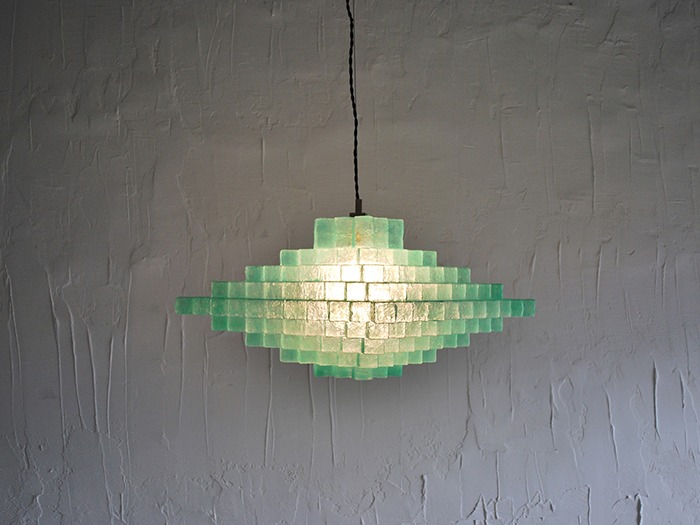
Archae are tectonic-looking structures that capture light and transform it. The mould is made of textured polystyrene, and its surface is reproduced by epoxy resin and fiberglass in a handmade process. Once the resin is catalysed, the mould is destroyed in order to detach the shell and a lampshade is created.
The result is a luminaire where light is projected through the cubic volumes in space, generating an illusion of basaltic, crystalline and disembodied architectures. The hardness of the shell, the evanescence of the light that it projects and the lightness of the created form, allow to create resounding and large structures.
Using LED light sources, the lighting is cozy, emotional, full of nuances, unique and personal.
The name Archae has a double etymological root: it comes from the ancient Greek, ἀρχαῖος, Arkhaios: belonging to the origin, primitive, ancestral; but also from the Latin Archa / Archae: ark, chest (base of the term Arcanus: secret, unfathomable).
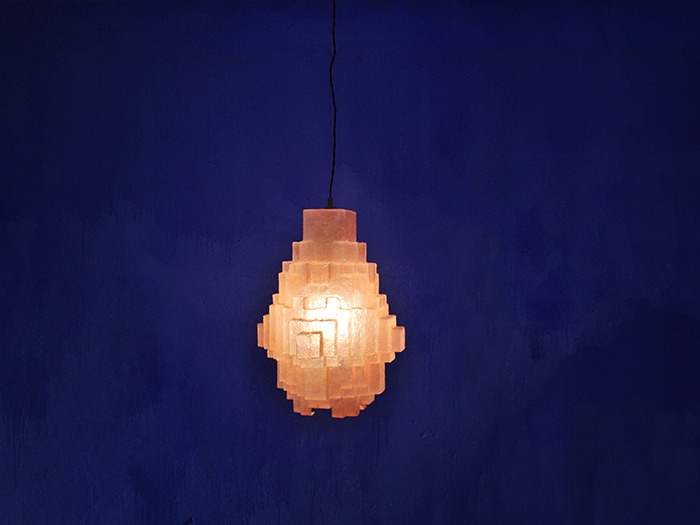
Chelsom honoured with Queen's Award for Enterprise in International Trade
(UK) - Chelsom presented prestigious Queen’s Award for second time in three years.
As Britain’s most coveted commercial prize, the awards celebrate and encourage business excellence in the UK. Chelsom has demonstrated outstanding results, achieving 59% growth in international sales over that period.
Exports now account for around 58% of all sales and Chelsom has built an exceptionally strong client base including major hotel operators such as Four Seasons, Mandarin Oriental, IHG, Hilton, Accor, Marriott and on the marine side, Disney Cruise Line, Carnival Cruise Lines, Royal Caribbean Cruise Lines, Virgin Voyages, Celebrity Cruises and Norwegian Cruise Lines.
Will Chelsom, Managing Director, has been instrumental in driving the Export division of the business and diversifying into the marine sector. He says: “We have achieved impressive export growth across multiple markets particularly in North America, the Middle East and Europe. Significant investment in our international sales team, corporate branding and overseas exhibitions have helped raise our international profile and undoubtedly contributed to our success.
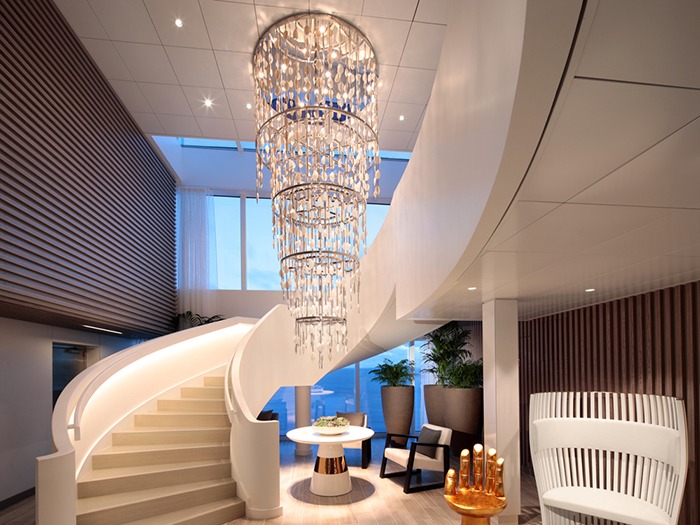
“Winning this export award is a huge honour but it is also confirmation that our innovative product design, overseas sales strategies and all of the accompanying hard work by our superb teams around the world is paying off.”
Robert Chelsom, Chairman, commented: “I am extremely proud that Chelsom has been awarded the Queen’s Award for Enterprise in International Trade for the second time in three years. We are honoured to receive this award on the back of 2019, our most successful year to date, as it acknowledges the hard work, dedication and passion that every employee has shown in helping to drive the business forward internationally. I am delighted to see that our third generation family business is continuing to expand and develop, cementing us as one of the major global players in the industry.”
Exploring the future of design and sustainability
Part of the 2019 [d]arc room: live series in collaboration with Light Collective, we look back at Helen Ankers' talk with product designer Daniel Fosbery on ensuring we design sustainably and with a conscience.
VISO - Feathers Collection
Meet Fred, Nancie, and Pablo – three lighting designs, including two table lamps and one floor lamp, that make up the new Feathers Collection from VISO.
The Feathers Collection is designed to inspire meaningful connections, with a profound sense of intimacy that is timeless. It showcases organic movement through avian-inspired shapes, lighting a path to community, freedom, and transformation. This refined collection is marked by modern elements and poised to enrich the profile of any space. Deep tones and elegant details reflect precision balanced by effortless grace and beauty.
Fred, Nancie, and Pablo stand strong on their own and collectively serve a powerful purpose. Together, they bring a certain harmony and renewal in the connections that bind us with a space. Each has variability in their diverse shapes, with equal sway in seamlessly adapting to their surroundings. Designed to entice your senses, the Feathers Collection is destined to transcend new heights.
“The Feathers Collection showcases our innovative approach to designs outside of suspended fixtures. Their diverse shapes and playfulness transcend the function of traditional lighting and gives new meaning to what lamps can do in a room,” says Tzetzy Naydenova, President of VISO.
“During
this time of uncertainty, we want to bring some joy, light and love to people.
That is why we decided to move forward with the launch of this collection. It’s
our way of connecting with our fans during this time of social distancing.”
Poised to make a statement no matter where he goes, Fred is bold, elegant, and majestic. Elevated by two brushed brass legs and a brass or stone base, this floor lamp features an opal glass diffuser that sits nicely on a high gloss-painted resin body. Fred radiates impeccable style and effortlessly assumes the centre of attention in any space. Fred is available in midnight blue with a brushed brass finish and base and in hot vanilla with a satin black finish and base. He measures 53.97in/1,371mm in height, 26in/660mm in leg height, 6in/152mm in lamp diameter, and features a dimmable 2700K LED.
Nancie is distinct, exquisite, and her magnetic presence is sure to light up any room. Her unique shape is complemented by her high gloss-painted resin body and the elegant brushed brass details on her neck, legs, and base. Nancie is unconventional and absolutely irresistible. Nancie measures 15.21in/386mm high with a 6in/152mm wide base and a 4in/102mm diameter lamp. She also features a dimmable 2700K LED and is available in the following finishes: midnight blue with a brushed brass finish and base, hot vanilla with a satin black finish and base, and smokey rose with a brushed brass finish and terrazzo stone base.
Pablo is calm, chic, enigmatic, and invites balance and introspection, bringing everything back into focus. He is light-hearted yet grounded and empowers every space with understated elegance. The curved brass neck reinforces his dynamism, enhanced by a frosted opal glass diffuser, a high-gloss painted resin body and brushed brass details. With Pablo, there is always more than meets the eye. Pablo measures 22in/559mm high with a 7in/180mm wide base. He also features a dimmable 2700K LED. Pablo is available in the following finishes: midnight blue with a brushed brass finish and base and hot vanilla with a satin black finish and base.
Moooi - Space
At first sight, you might think that the Space table lamp is a mirror that plays with your environment. However, as soon as you touch the dimmer you discover hidden lamps beneath its surface.
Space, designed by Ward Wijnant, creates various lighting explorations that transform your interior space. Switch on the dimmer and be guided into a parallel dimension. As if it came from another dimension, it wants to adapt to your environment. During the day, it sits quietly with its mirrored appearance reflecting its surroundings. Then in the dark of the night, it loves to shine its mysterious lights. Make sure to pay close attention, because when it does, its silver surface will become translucent and a new world will appear from within its ostensible mirror.
About the designer
Ward Wijnant started out at the Wood and Furniture College, where he developed his furniture making techniques and a wide knowledge about materials. He continued his career at the Design Academy Eindhoven where he graduated as an independent designer. He started his own company in 2015. Ward’s work is characterised by experimenting with materials. It is his mission to interpret the diversity of older methods and materials, translating them into contemporary designs that pay attention to detail and finish. This unexpected element of discovery is what’s meaningful in a product or design.
The Button
The Space table lamp is accompanied by Moooi’s digital proof of authenticity: The Button. This personal safe keeper accompanies every Moooi design. The incorporated NFC- technology in The Button makes counterfeiting impossible and acts as proof of authenticity. With registering the purchase to your own name, you secure your investment and in addition will extend the warranty.
Hollands Licht - 24
New to the Hollands Licht collection is 24 by Dutch designer Julia Raymakers. A dynamic lighting design that helps to align your daily rhythm by providing the right light for every time of the day. Human centric lighting by individual control of the colour temperature and / or the light intensity (dimming), the light is adjusted to the desired function and mood of the moment.
Twenty Four includes two light sources that provide direct and indirect light. The LED strip is multifunctional by being dimmable and adjustable in colour temperature from 2700K to 4000K. It provides general lighting for focus, working and concentration as well as warm light for breakfast and lunch. The LED spot provides intimate light for cosy and relaxed occasions.
Both sources can be switched on/off and adjusted in light intensity independently by integrated touch dimmers. The fixture can rotate 360°, which makes it possible to switch between working and living 24 hours a day.
Designed, developed, and produced in the Netherlands where Hollands Licht works together with local craftsmen, the fixture is handmade in a social working place by people who have a distance to the labour market and society.
Julia Raymakers, who studied Industrial Design at the Technical University Delft, is driven by the continuous search for more social and environmental friendly design that contributes to a better world, now and in the future. UNICEF calculated that in 2050 70% of the world population will live in cities. With the design of 24, Raymakers is responding to this trend, as co-working and co-living will beome more common every day.


